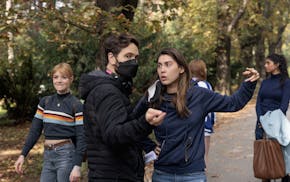DULUTH – The accolades have been pouring in for this once-rusting industrial city on Lake Superior.
Lonely Planet lauded it as a top 10 U.S. destination, and AARP acclaimed it as a good place to live. Just last month, the International Mountain Bicycling Association named Duluth one of only six gold-rated ride centers on the planet.
But perhaps the most visible coup came from a locally led effort of online voting that hoisted Duluth to the top of Outside Magazine's "Best Towns" contest last year.
"The community is on fire," lifelong Duluthian Sanford Hoff said as he walked the muddy construction site of a $29 million Pier B Resort that he is codeveloping on the bay — the next in a string of industrial sites that have been refurbished along the water. "The quality of life has always been tremendous here, but we're really starting to … realize what the opportunities are."
Such positive attention is the envy of midsize cities across America.
So how did Duluth do it?
City leaders started long, long ago with careful plans, lots of patience and, most recently, loud cheerleading.
But the city's image renaissance hasn't yet translated into population increases and postrecession job recovery, measures that civic leaders say they are still working to improve.
"The spirit that Duluth is capturing right now is one of energy and creative entrepreneurship," 41-year-old, two-term Mayor Don Ness said. "When you're a city that attracts high-energy, creative people, you can tap into that and make it the engine for the progress that you really need to sustain."
Turn out the light
Duluth was anything but vibrant in the early-1980s. Much of its prime waterfront had been industrial and closed off to the public. U.S. Steel and other industries had left town. A billboard asked the last person leaving Duluth to turn out the light.
In a 1985 plan to redevelop the downtown waterfront, then-mayor John Fedo wrote that the city had "an opportunity to uncover a jewel."
The plan identified the land jutting out to the Duluth lift bridge, once laden with junk cars and metal scraps, as the high priority for hotels, restaurants and shops.
At that point, just a handful of nonindustrial businesses had taken a chance on the area known as Canal Park. Andy Borg and Mick Paulucci, the son of a frozen-food magnate, had converted a bar — and a one-time brothel — into a saloon and grill they called Grandma's.
"It was away from everything," company President Brian Daugherty recently said of the area that was key to Duluth's spreading tourism industry.
Decades later, the city, led by Ness, also tackled city employee retiree health care obligations that had left it headed toward bankruptcy. Companies wouldn't invest in a city on the verge of financial ruin, Ness said.
Leaders eventually figured out what experts call a key point in revitalization: Instead of emulating other successful cities, they found their unique strengths — the world's largest freshwater lake as well as the steep slope on which the city is built, with its swaths of undeveloped green space.
It's a strategy many cities don't pursue when trying to change perceptions, said Aaron Renn, a senior fellow at the Manhattan Institute for Policy Research in New York.
Every city "tries to convince you it's exactly the same as every other city that's sort of conventionally considered cool," Renn said, highlighting foodie restaurants, coffee shops, craft beer and hipsters.
"You have to be willing to portray yourself as authentically who you are," he said. "You have to be willing to say: 'Look, we're not for everybody.' "
More recently Duluth has been aiming to do just that, embracing its rugged surroundings to appeal to people who prefer wilderness and water instead of high rises; flannel over cashmere, athleticism over leisure.
They are also touting the city's industrial history, with oceangoing ships still using the port and old warehouses being refurbished into vibrant spaces.
"Most cities put a premium on making life easy," Ness told Bicycling magazine last year. "Cities like Duluth put a premium on making life interesting."
Leaders have focused on building trails for hiking, cross-country skiing, snowshoeing and off-road biking. Already, the city's mountain bike trails, anticipated to cover 100 miles, have drawn attention as far away as Europe. City leaders are now looking to turn an old gravel quarry into a climbing facility, particularly for ice climbing in winter. Kayak boat landings and a cross-country ski center are also planned.
Still, they acknowledged, there is more work to be done. City streets need repair. Some neighborhoods feel neglected.
But with a critical amount of amenities in place, Duluth is starting to reap the benefits of a changed reputation. But even that has taken work.
"This whole idea that if you build it they will come? That's a crock of crap," said longtime Duluth businessman Rod Raymond, who co-owns several restaurants. "You've got to build it and scream out loud that it's here."
Population still flat
Still, the question remains whether Duluth's newfound attention will pay off in long-term, concrete ways.
After peaking at 106,000 residents in the 1960s, the city's population has hovered around 86,000 in recent years. Meanwhile, Rochester grew by 4.4 percent from 2010 to 2014, and St. Cloud inched up .7 percent. Duluth's mayor put out a challenge to increase the population to 90,000 by 2020.
While the city's economy has seen more growth in professional, scientific and technical services than other large Minnesota cities, the Duluth area hasn't regained its pre-recession job numbers, unlike the Rochester, Mankato, St. Cloud and Twin Cities areas.
"We're on a roll, and every indication is that the jobs will continue to expand here and, with that, we think the population will be increasing," said David Ross, president of the Duluth Area Chamber of Commerce.
Cranes are now building a new corporate headquarters for clothing chain Maurices. Cirrus Aircraft is growing in town. Modern outdoor furniture maker Loll Designs expects to expand.
Addressing a market-rate housing shortage, large new apartment complexes are going up, too.
Young residents, said Hoff, the developer, realize they can "make a decent living in Duluth, and can have water sports, biking, snowmobiling, skiing, everything five minutes out my back door."
That helped lure Eleanor and Mason Bacso. The couple grew up in the Twin Cities area, went to Duluth for college, then moved away for jobs and grad school.
They became big fans of mountain biking, so when Mason was offered a physical therapy job back near Duluth, they didn't hesitate to move.
They bought a 1950s house in the Lincoln Park neighborhood, where just a block up the hill, the Duluth Traverse mountain biking trail is slated to come through next year.
"That was one of the big reasons we decided to come back," said Eleanor, 25, her forearm dotted with Band-Aids from a biking fall. "There's the city here and wilderness also."
Outdoors enthusiasts Melody and Ben Botnen moved from the Twin Cities to Duluth with their young daughter in July, after convincing their employer to let them transfer. After graduating from college here, they'd been trying to move back for eight years.
"Ever since we left, we were thinking to ourselves: Why did we leave?" Melody said. "You can go three minutes from your house and be where no one else is."
Pam Louwagie • 612-673-7102

Perfection comes with a reward in the baseball Metro Top 10

Chaska native's directorial debut 'Tarot' will be in 3,500 theaters

